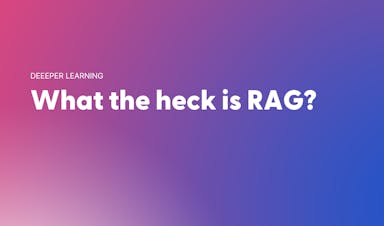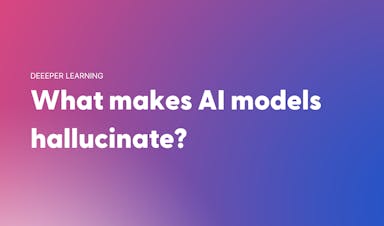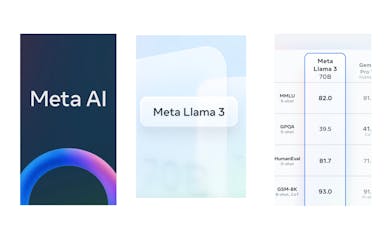What is generative AI? How AI tools like ChatGPT and DALL-E work

AI is a rapidly evolving field that is transforming the way we create and interact with digital content but what exactly is generative AI and how does it work?
It’s likely you’ve heard of the term because of the emergence of popular AI apps such as ChatGPT and DALLE-2 that uses the technology to create its output.
While the latter is an example of an AI art generator that can produce original artwork based on prompts a user inputs into the application, chatbots also use the technology to produce human-like responses to user queries.
But how are they trained? And what are the differences between the types of learning?
What is generative AI?
Put simply, generative AI refers to algorithms that are capable of producing content across various formats, such as text, images, videos, simulations, code, and audio.
Generative AI typically involves using deep learning algorithms, such as generative adversarial networks (GANs) or variational autoencoders (VAEs), that are trained on large datasets of existing content. These algorithms can then generate new content by extrapolating from the patterns and features of the training data.
How does generative AI work?
Generative AI works by using a model to learn the underlying patterns and structure of a dataset without being explicitly told what to look for. This approach is different from predictive AI, which uses labeled data to make predictions.
Generative AI models can be trained on various types of data, such as text, images, or audio. The goal of the model is to learn the underlying probability distribution of the data, which allows it to generate new data that is similar to the original dataset.

ChatGPT
What is ChatGPT, DALL-E and other examples of AI applications?
ChatGPT is a language model that has been pre-trained on vast amounts of text data that allows it to generate human-like responses to user queries in real-time.
When a user inputs a question or statement, ChatGPT uses pre-trained knowledge to generate a response that is relevant to the input. This can vary in length, style and tone depending on the context. The application also uses machine learning algorithms to continuously improve its responses based on user feedback. This means that as more people use and interact with ChatGPT, it becomes better at generating relevant and accurate responses.
Like ChatGPT, DALLE-2 is also developed by OpenAI, an AI research and deployment company. It uses a combination of deep learning and natural language processing to create images from textual descriptions and is trained on a large dataset of images and text which enables it to learn how to generate images that accurately match the corresponding textual input.
Although these are two of the most popular examples, there are actually a huge number of AI apps available, with new ones constantly being developed, such as HuggingChat, an open source alternative to ChatGPT.
What companies are using generative AI?
Big tech companies such as Amazon, Microsoft and Google have all been integrating AI into their products.
Arguably one of the most famous examples of AI in recent times is Amazon’s Alexa and Siri voice assistants, while Microsoft Bing has introduced OpenAI features to its search engine including its very own AI art generator powered by DALL-E called Microsoft Image Creator. Google too has responded by creating ChatGPT competitor Bard and is working on a new version of its search engine called Project Magi.
Other companies who are integrating AI into their products include Notion, Buffer, Quora and Grammarly.

Microsoft Image Creator
What is the difference between predictive AI and generative AI?
Predictive AI, also known as supervised learning, involves training a model on labeled data to make predictions on new, unseen data. This approach relies on historical data to make predictions about future events or outcomes. The goal of predictive AI is to make accurate predictions based on a set of features or inputs.
Generative AI, on the other hand, involves creating new data that is similar to a given dataset. This approach is used to generate new content, such as images, videos, or text. Generative AI models use unsupervised learning techniques to learn the underlying patterns in a dataset and then use those patterns to generate new content.
What’s the difference between artificial intelligence and machine learning?
Artificial intelligence refers to the broader concept of creating intelligent machines that can perform tasks that typically require human intelligence, such as perception, reasoning, learning, problem-solving, and decision-making. AI can include many different techniques and approaches, such as expert systems, rule-based systems, and neural networks.
Machine learning, on the other hand, is a specific subset of AI that focuses on training algorithms to learn from data and improve their performance over time without being explicitly programmed. In other words, machine learning is a way of achieving artificial intelligence.
Why is generative AI so popular?
The ability to create new content, the flexibility of unsupervised learning, advances in deep learning, availability of large datasets, and a wide range of applications have all made generative AI a popular area of research and development.
Generative AI has many applications in various industries, such as entertainment, gaming, marketing, and healthcare. It can be used to create personalized content for marketing campaigns, generate realistic simulations for training purposes, or produce synthetic data for medical research.
What are the dangers of generative AI?
There are several concerns around the use of generative AI including ethical and privacy concerns. The use of AI art generators, for example, has raised issues around artist copyright: how the tools are trained and who owns the content generated by these models.
The spread of misinformation and fake content has also generated news headlines in recent times, with fake images of Donald Trump and The Pope going viral leading to questions around how to spot an AI- generated image.
Privacy and data protection has also been frequently cited as a danger of generative AI tools. ChatGPT has been banned in several countries including Italy after the country’s data protection watchdog claimed that ChatGPT did not comply with the European General Data Protection Regulation (GDPR).
As generative AI models can be trained on personal data, such as images or voice recordings, privacy concerns have been thrust into the spotlight with OpenAI introducing new ways to turn off chat history, allowing users to decide which conversations can be used to train their models.
Comments (10)
Aziz Elfituri@aziz_elfituri
Great 👍
Share
Great post! It caught my attention especially because we've embedded ChatGPT + fine-tuned image generation models into a mobile interface.
It's honestly a future everyone has to adapt to quickly.
Very good write up! Might be worth noting that Italy is allowing it again, but OpenAI is considered "high risk" under the new EU AI Act, so it has to go through additional audits and transparency measures.
More stories

Aaron O'Leary · News · 4 min read
Q&A: What the heck is RAG?

Sarah Wright · News · 3 min read
Q&A: What makes AI models hallucinate?

Kyle Corbitt · How To · 3 min read
What we've learned in 3 days of Llama 3

Aaron O'Leary · Announcements · 2 min read
Introducing Shoutouts

Finn Lobsien · Opinions · 5 min read
Can Devin AI Replace Product Managers?

